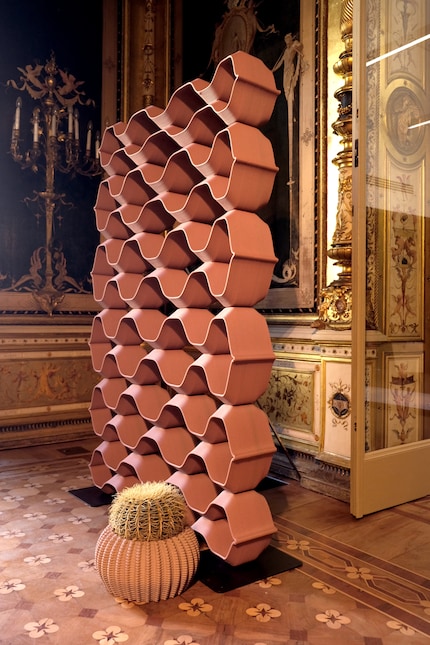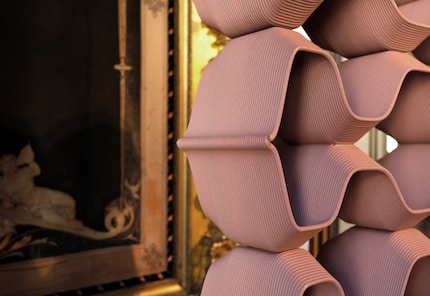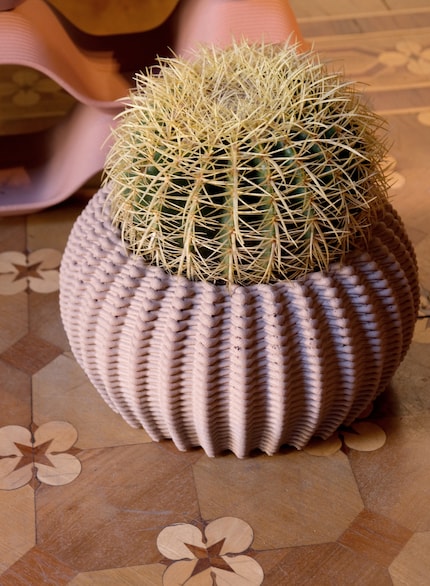Which trash item do you think the room divider is made of?
Submit your guess, then read on to find the solution.
- Tin cans1%
- Tetra Paks50%
- Aluminium tubes2%
- Yoghurt pots31%
- Plastic tubes16%
The competition has ended.

A Dutch company is making 3D-printed furniture out of something we throw away millions of times a day. Can you guess what this room divider is made of?
Amsterdam-based Aectual is one of the first design companies to recycle large amounts of plastic waste produced by brands such as Nike, Disney and Burberry. At the last Milan Furniture Fair, it showcased a line of products that emerged from a collaboration with a Swiss company. The collection is made from something you’d be sure to find in your bin. Maybe you’ll be able to guess what it is once you read the next section.

Although the company is now based in Switzerland, our mystery material was invented in Sweden. Usually consisting of up to seven layers of different materials, it allows food products to be hygienically packed in tight spaces. The outermost, smooth layer is almost always multicoloured. It’s used to present products for sale in an appealing way. In the 1950s it took the form of a pyramid after being filled and sealed. These days, however, you’ll find it in a variety of shapes.
Submit your guess, then read on to find the solution.
The competition has ended.

The folding screen is characterised by its clay-like appearance, but its terracotta colour is deceptive. The name of the design reveals different origins: Aectual Drink Carton is comprised of polymers and aluminium (PolyAl) made of – yep, you guessed it – discarded drinks cartons. It’s the result of a collaboration with Tetra Pak,
which previously only ever used the cardboard layer of its cartons to produce new packaging. Aectual, however, has managed to transform the leftover PolyAI into raw material for 3D printing, which the designer brand uses for its own products. In doing so, the Dutch design firm offers large companies such as Tetra Pak a way to reduce their ecological footprint. In a press release, Tetra Pak says, «3D printing leads to an 80% CO2 reduction because products are created using less materials.» Because the folding screens are only manufactured as required, none of the products need to be stored in warehouses.
PolyAl is ideally suited as a building material. The room divider is just one example. It’s part of a concept called Playbook, which includes stools, planters, wall coverings, room dividers, fly screens and much more.

To make the repurposing of its waste a success, Tetra Pak has set up an ecosystem with other partners. Recon Polymers takes care of material recycling and Innolab Chemistry is responsible for compounding. Aectual makes new 3D-printed interior products using the material from shredded drinks cartons. At the end of the process, Playbook will be used internally by Tetra Pak teams to design their office and choose a set-up for it. In this way, the Swiss company ensures that neither the recycling of the cartons nor the design of the working environment is left to chance.
This is the fourth instalment of the «Guess what?» series, in which you can use my clues to guess a design piece’s «secret ingredient». You can find previously published articles in the series here:
Header image: Pia Seidel
Like a cheerleader, I love celebrating good design and bringing you closer to everything furniture- and interior design- related. I regularly curate simple yet sophisticated interior ideas, report on trends and interview creative minds about their work.
Interesting facts about products, behind-the-scenes looks at manufacturers and deep-dives on interesting people.
Show all